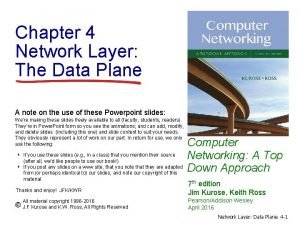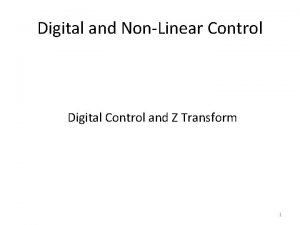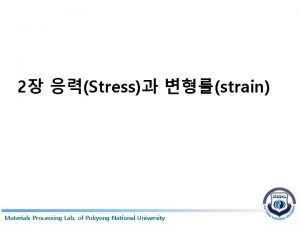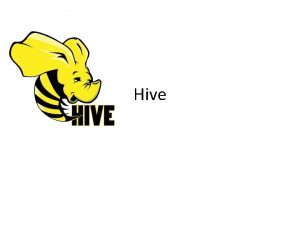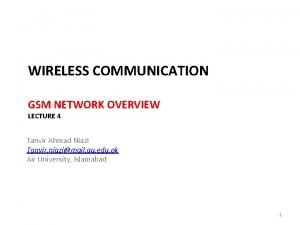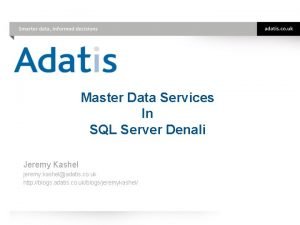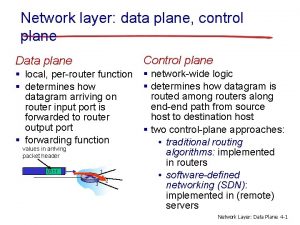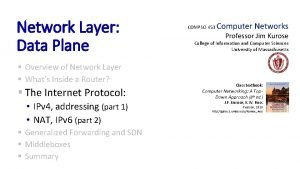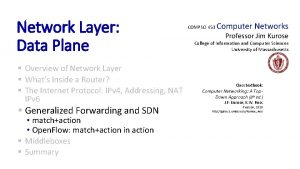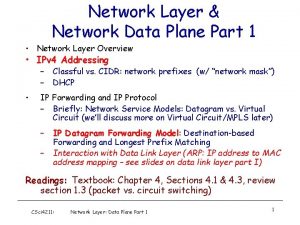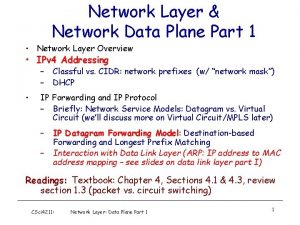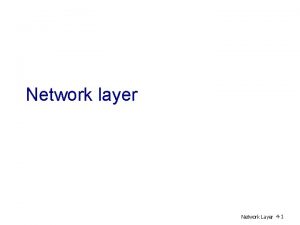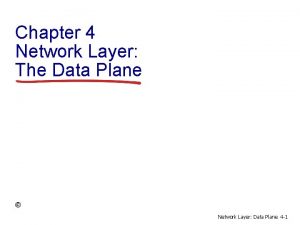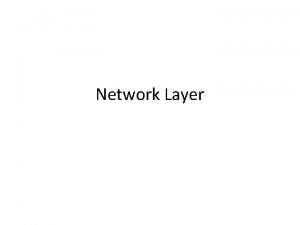Network Layer Data Plane Overview of Network Layer












- Slides: 12

Network Layer: Data Plane § § Overview of Network Layer What’s Inside a Router? The Internet Protocol: IPv 4, Addressing, NAT IPv 6 Generalized Forwarding and SDN § Middleboxes COMPSCI 453 Computer Networks Professor Jim Kurose College of Information and Computer Sciences University of Massachusetts Class textbook: Computer Networking: A Top. Down Approach (8 th ed. ) Pearson, 2020 http: //gaia. cs. umass. edu/kurose_ross • middlebox functions • evolution, architectural principles of the Internet § Summary J. F. Kurose, K. W. Ross

Middleboxes Middlebox (RFC 3234) “any intermediary box performing functions apart from normal, standard functions of an IP router on the data path between a source host and destination host”

Middleboxes everywhere! Firewalls, IDS: corporate, national or global ISP NAT: home, institutional, service providers, ISPs cellular, institutional Load balancers: corporate, service provider, data center, mobile nets Applicationspecific: service providers, institutional, CDN datacenter network Caches: service enterprise network provider, mobile, CDNs

Middleboxes § initially: proprietary (closed) hardware solutions § move towards “whitebox” hardware implementing open API § move away from proprietary hardware solutions § programmable local actions via match+action § move towards innovation/differentiation in software § SDN: (logically) centralized control and configuration management often in private/public cloud § network functions virtualization (NFV): programmable services over white box networking, computation, storage

The IP hourglass Internet’s “thin waist”: § one network layer protocol: IP § must be implemented by every (billions) of Internet-connected devices HTTP SMTP RTP QUIC DASH TCP UDP IP Ethernet PPP … PDCP Wi. Fi Bluetooth copper radio fiber … many protocols in physical, link, transport, and application layers

The IP hourglass, at middle age HTTP SMTP RTP QUIC DASH Internet’s middle age “love handles”? § middleboxes, operating inside the network TCP UDP caching N NAT IP Firewalls FV Ethernet PPP … PDCP Wi. Fi Bluetooth copper radio fiber …

Architectural Principles of the Internet RFC 1958 “Many members of the Internet community would argue that there is no architecture, but only a tradition, which was not written down for the first 25 years (or at least not by the IAB). However, in very general terms, the community believes that the goal is connectivity, the tool is the Internet Protocol, and the intelligence is end to end rather than hidden in the network. ” Three cornerstone beliefs: § simple connectivity § IP protocol: that narrow waist § intelligence, complexity at network edge

The end-end argument § some network functionality (e. g. , reliable data transfer, congestion) can be implemented in network, or at network edge application transport network data link physical end-end implementation of reliable data transfer application transport network data link physical hop-by-hop (in-network) implementation of reliable data transfer network link physical network link physical application transport network data link physical

The end-end argument § some network functionality (e. g. , reliable data transfer, congestion) can be implemented in network, or at network edge “The function in question can completely and correctly be implemented only with the knowledge and help of the application standing at the end points of the communication system. Therefore, providing that questioned function as a feature of the communication system itself is not possible. (Sometimes an incomplete version of the function provided by the communication system may be useful as a performance enhancement. ) We call this line of reasoning against low-level function implementation the “endto-end argument. ” Saltzer, Reed, Clark 1981

Where’s the intelligence? 20 th century phone net: • intelligence/computing at network switches Internet (pre-2005) • intelligence, computing at edge Internet (post-2005) • programmable network devices • intelligence, computing, massive application-level infrastructure at edge

Chapter 4: done! § Network layer: overview § What’s inside a router § IP: the Internet Protocol § Generalized Forwarding, SDN § Middleboxes Question: how are forwarding tables (destination-based forwarding) or flow tables (generalized forwarding) computed? Answer: by the control plane (next chapter)

Network Layer: Data Plane § § Overview of Network Layer What’s Inside a Router? The Internet Protocol: IPv 4, Addressing, NAT IPv 6 Generalized Forwarding and SDN § Middleboxes COMPSCI 453 Computer Networks Professor Jim Kurose College of Information and Computer Sciences University of Massachusetts Class textbook: Computer Networking: A Top. Down Approach (8 th ed. ) Pearson, 2020 http: //gaia. cs. umass. edu/kurose_ross • middlebox functions • evolution, architectural principles of the Internet § Summary J. F. Kurose, K. W. Ross
 Software-defined networking: a comprehensive survey
Software-defined networking: a comprehensive survey Network layer data plane
Network layer data plane Forward equivalence class
Forward equivalence class Data cleaning problems and current approaches
Data cleaning problems and current approaches Data quality and data cleaning an overview
Data quality and data cleaning an overview Data quality and data cleaning an overview
Data quality and data cleaning an overview Comparison of virtual circuit and datagram subnets
Comparison of virtual circuit and datagram subnets Z transform is a non-linear function
Z transform is a non-linear function 체적변형률
체적변형률 Javachive
Javachive Gsm network overview
Gsm network overview Master data services overview
Master data services overview Mds sql server
Mds sql server

